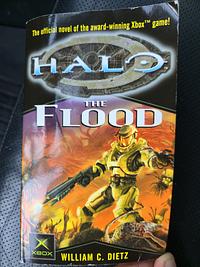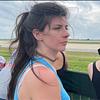Take a photo of a barcode or cover
adventurous
sad
tense
medium-paced
Plot or Character Driven:
Plot
Strong character development:
No
Loveable characters:
Yes
Diverse cast of characters:
Yes
Flaws of characters a main focus:
Complicated
A really good book on the events of the flood. As a fan of the halo game series it was awesome to get more information about how the flood came to be.
adventurous
dark
tense
medium-paced
Plot or Character Driven:
Plot
Strong character development:
Yes
Loveable characters:
Yes
Diverse cast of characters:
Complicated
Flaws of characters a main focus:
No
This was a wild ride. Almost a perfect novelization of the first game and I loved every minute of it. The ending crushed me a little, not gunna lie. Pacing was excellent, characters were decent, plot was good, tons of nostalgia. If you like the Halo games, this is a fun read.
adventurous
inspiring
mysterious
tense
medium-paced
Plot or Character Driven:
A mix
Strong character development:
Yes
Loveable characters:
Yes
Diverse cast of characters:
Yes
Flaws of characters a main focus:
No
it’s so good !! reading the books adds more context into the games. this book in particular made me love captain keyes more than i did in the game.
adventurous
inspiring
tense
fast-paced
Plot or Character Driven:
A mix
Strong character development:
Yes
Loveable characters:
Yes
Diverse cast of characters:
Yes
Flaws of characters a main focus:
No
adventurous
emotional
sad
tense
fast-paced
Plot or Character Driven:
Plot
Strong character development:
Yes
Loveable characters:
Yes
Diverse cast of characters:
Yes
Flaws of characters a main focus:
No
This is the second novel in the Halo series and starts where the first volume leaves off. The Pillar of Autumn has escaped from Reach and arrived at the mysterious Halo ring world where the fate of humanity will apparently be decided.
Perspectives are slightly broader in this novel because the scenes with humans are interspersed with scenes showing Covenant characters. This means that we learn a little bit about Covenant society, such as some kind of hierarchy with Prophets at the top, then the Elites, then the Jackals and Hunters, and the Grunts at the bottom. The Covenant mirror some aspects of humanity, especially in a military sense: the chain of command, ambition, subservience, punishments for failure. The Grunt Yayap is a vaguely comic character. He dreams of being back home in some kind of luxurious swamp. He rescues a wounded Elite during a firefight, only because taking the Elite back behind the lines for medical treatment will mean that he won’t have to do any more fighting. Unfortunately, when the Elite recovers he gets Yayap redeployed to serve as his assistant. This is terrible news for Yayap because the Elite has set himself a mission to search out and destroy the Master Chief. Gulp!
On the whole, though, whereas the human Marines and “Helljumpers” are courageous and resourceful, the aliens are just nasty. Unfortunately, humanity not only has to contend with the Covenant in this novel. They face a new enemy, the parasitic Flood. These are little squid-like creatures who latch onto humans and Covenant alike, infiltrate their brains and take over their bodies. Not only that, the Master Chief stumbles across an AI called 343 Guilty Spark and a bunch of flying robots called the Sentinels. Guilty Spark wants the Master Chief to help him destroy the Flood, which sound great until Cortana discovers that Guilty Spark also wants to destroy all sentient life in the galaxy…..
This novel was written in 2005 and you can’t help thinking that the author had more than half an eye on what was happening at the time in Iraq and Afghanistan. I had an uneasy feeling that the Covenant were an amalgam of the Taliban, Al Qaida, China and other indeterminate enemies of the “West”.
The novel is filled with military action, not surprising given that it is based on a video game. However, I was slightly mystified that, whereas at starship level the Covenant are apparently way superior to humanity technologically, when it comes to warfare on the ground they are much more evenly matched. Although the novel is set in five hundred years’ time, that military action sounds very contemporary. There’s a lot of talk about assault rifles and sniper’s rifles and main battle tanks. Even shotguns. The author also feels a need to give us the precise calibre of the projectiles that each weapon fires as well as other data, such as high many rounds a magazine holds. And all the military characters sound suspiciously like nineties and noughties Americans. It also sounds like they all come from Earth, which makes you wonder why the state or empire or whatever it is can’t recruit personnel from its colonies.
I’m a war buff but it would be good if we got a broader perspective in the remaining volumes in the Halo series. For a start, I’d like to know what’s happening on the home front. What is civilian life like? What politics is going on? Who runs this empire? We’re told that the Spartan programme was originally conceived to counter internal rebellion rather than to take on aliens. What was this rebellion all about? So far, we don’t know. I keep comparing the Halo series with The Expanse. The latter has plenty of action, plenty of blood and guts and violence and I’m all for that. But it also has a large number of well-rounded characters and a lot of detailed background that helps you make sense of the universe they operate in. So far we’re not getting that here. The characters seem to be like US military personnel from any period from World War II to the War on Terror via Vietnam. They operate in a vacuum with no reference to the politics and economics that contributed to creating their attitudes and beliefs or the technology they’re using.
I will continue reading the Halo series but so far it is not in the same league as The Expanse, and I do hope it gets better.
Perspectives are slightly broader in this novel because the scenes with humans are interspersed with scenes showing Covenant characters. This means that we learn a little bit about Covenant society, such as some kind of hierarchy with Prophets at the top, then the Elites, then the Jackals and Hunters, and the Grunts at the bottom. The Covenant mirror some aspects of humanity, especially in a military sense: the chain of command, ambition, subservience, punishments for failure. The Grunt Yayap is a vaguely comic character. He dreams of being back home in some kind of luxurious swamp. He rescues a wounded Elite during a firefight, only because taking the Elite back behind the lines for medical treatment will mean that he won’t have to do any more fighting. Unfortunately, when the Elite recovers he gets Yayap redeployed to serve as his assistant. This is terrible news for Yayap because the Elite has set himself a mission to search out and destroy the Master Chief. Gulp!
On the whole, though, whereas the human Marines and “Helljumpers” are courageous and resourceful, the aliens are just nasty. Unfortunately, humanity not only has to contend with the Covenant in this novel. They face a new enemy, the parasitic Flood. These are little squid-like creatures who latch onto humans and Covenant alike, infiltrate their brains and take over their bodies. Not only that, the Master Chief stumbles across an AI called 343 Guilty Spark and a bunch of flying robots called the Sentinels. Guilty Spark wants the Master Chief to help him destroy the Flood, which sound great until Cortana discovers that Guilty Spark also wants to destroy all sentient life in the galaxy…..
This novel was written in 2005 and you can’t help thinking that the author had more than half an eye on what was happening at the time in Iraq and Afghanistan. I had an uneasy feeling that the Covenant were an amalgam of the Taliban, Al Qaida, China and other indeterminate enemies of the “West”.
The novel is filled with military action, not surprising given that it is based on a video game. However, I was slightly mystified that, whereas at starship level the Covenant are apparently way superior to humanity technologically, when it comes to warfare on the ground they are much more evenly matched. Although the novel is set in five hundred years’ time, that military action sounds very contemporary. There’s a lot of talk about assault rifles and sniper’s rifles and main battle tanks. Even shotguns. The author also feels a need to give us the precise calibre of the projectiles that each weapon fires as well as other data, such as high many rounds a magazine holds. And all the military characters sound suspiciously like nineties and noughties Americans. It also sounds like they all come from Earth, which makes you wonder why the state or empire or whatever it is can’t recruit personnel from its colonies.
I’m a war buff but it would be good if we got a broader perspective in the remaining volumes in the Halo series. For a start, I’d like to know what’s happening on the home front. What is civilian life like? What politics is going on? Who runs this empire? We’re told that the Spartan programme was originally conceived to counter internal rebellion rather than to take on aliens. What was this rebellion all about? So far, we don’t know. I keep comparing the Halo series with The Expanse. The latter has plenty of action, plenty of blood and guts and violence and I’m all for that. But it also has a large number of well-rounded characters and a lot of detailed background that helps you make sense of the universe they operate in. So far we’re not getting that here. The characters seem to be like US military personnel from any period from World War II to the War on Terror via Vietnam. They operate in a vacuum with no reference to the politics and economics that contributed to creating their attitudes and beliefs or the technology they’re using.
I will continue reading the Halo series but so far it is not in the same league as The Expanse, and I do hope it gets better.
adventurous
challenging
emotional
funny
hopeful
medium-paced
Plot or Character Driven:
Plot
Strong character development:
Yes
Loveable characters:
Yes
Diverse cast of characters:
Yes
Flaws of characters a main focus:
No




